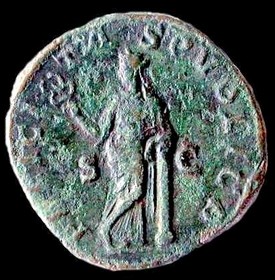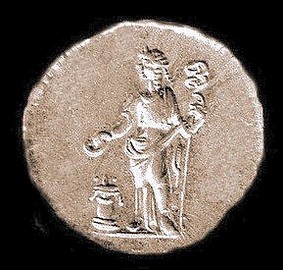Felicitas was celebrated in Rome as a protective deity since 74 BC. As the personification of happiness, joy and cheerfulness, she also indicated success and good luck. Her Greek equivalent is Eutycheia. Felicitas frequently appears as a reverse type on Roman coinage from the reign of Galba on until the reign of Severus. Her attributes include a cornucopia, sceptre or caduceus (the latter for prosperity in trade). Occasionally she is depicted holding corn-ears, a patera, victoriola or capricorn (sea-goat), sometimes she is shown leaning on a column or sacrificing at an altar. Coin depictions of Felicitas sometimes conveyed the message that the empress had given birth. Various common reverse legends allude to either the happiness of the emperor (FELICITAS AVG); the public (FELICITAS PVBLICA); the world (FELICITAS ORBIS); a particular time (FELICITAS TEMPORVM), or a particular age (FELICITAS SAECVLI). |
 |
 |
The sestertius above depicts on the reverse Felicitas standing, head turned left, holding a caduceus, and leaning on a column. The obverse displays Julia Mamaea, mother of Severus Alexander. |